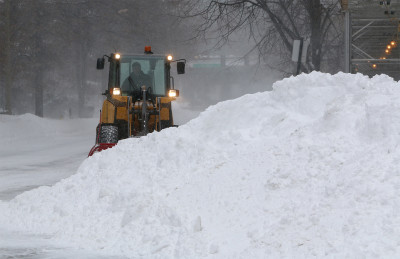 After a winter that brought a record amount of snow to the city and halted businesses and transportation statewide, the City of Boston looks to improve snow removal efforts for the upcoming snow season.
After a winter that brought a record amount of snow to the city and halted businesses and transportation statewide, the City of Boston looks to improve snow removal efforts for the upcoming snow season.
Boston received 110.6 inches of snow between July 1, 2014, and June 30, 2015, according to The Weather Channel. Much of that snow was taken to a large snow pile in South Boston that did not completely melt until July.
The Boston Public Works Department hopes to improve methods of snow removal for the coming winter by using machinery, said Gabrielle Farrell, a spokeswoman for Boston Mayor Martin Walsh.
“The [snow blowers] have the ability to throw 2,750 tons of snow per hour with a casting distance up to 150 feet,” Farrell said. “The blowers will be mounted on 4-wheel front-loaders from Volvo Construction Equipment, with tires over 4 feet in diameter. Large dump trucks, with capacities about 10 to 16 cubic yards, can move along with the blowers, catch snow and cart it to disposal sites.”
Charlestown, Hyde Park and Dorchester have been designated as neighborhoods for snow piling, Farrell said, but the plans are not definite.
“The [Public Works Department] is still in the process of solidifying parcels of land in all parts of the City if removal becomes the norm again,” Farrell said.
More than 40,000 truckloads of snow were removed from city streets this past winter, Farrell said.
Bruce Anderson, a professor who conducts research on climate change at the Boston University College of Arts and Sciences, said that despite forecasts, it is difficult to predict precipitation for the New England region.
“In addition, there is the added complication of trying to predict whether that precipitation falls as snow or rain,” Anderson wrote in an email. “The change in climate that we already have experienced over the last half century certainly plays a role in modifying the weather events that impact our region, principally by feeding them with more moisture and energy.”
David Kimbro, a professor of ecology and conservation at Northeastern University, said El Niño, a periodic shift in the ocean-atmosphere system, could play a role in this winter’s conditions.
“A lot of areas are going to be a lot warmer this year, but weirdly our local climate is apparently supposed to be cooler again,” Kimbro said. “So that may bring conditions like we saw last winter.”
Kimbro, new to the Boston area, said he isn’t familiar with the city’s snow removal methods, but that he is interested in the science behind run-off created from melting snow.
“One interesting project that young scientists could get into is looking at how the melting of that much fresh water and the run off affects coastal ecosystems,” Kimbro said. “That would be a nice project to undertake.”
Several residents agree that last winter’s snowfall exceeded any and all expectations, which gives them apprehension for the upcoming winter. They said they are hopeful that removal efforts will be better this season.
Dawson Rauch, 26, of Jamaica Plain, said the snow totals from last winter were “pretty incredible” and Boston did well, considering the circumstances.
“Lots of snow, lots of big snow banks. It was a hard winter. [My] car got buried, everyone got buried,” he said. “They [the city] did a pretty good job with as much snow as there was.”
Monica Slocum, 35, of Roxbury, who recently moved from Salem, said it was difficult dealing with the snow in the city.
“I was here a lot, and I mean it was a mess,” he said. “I’m not sure what more could have been done. I even had my car towed at one point. It wasn’t safe.”
Ryan Holohan, 41, of East Boston, said he worried about his family’s safety and his business during last winter’s snowfall.
“I had to carve out deep canals for my children to walk to the bus stop when there was school, and it affected my work dramatically,” he said. “I was really backed up with my clients … [however] I like how they prioritized removing snow from dangerous corners because that was a big concern.”




